Russians, Rice Farmers and War Tourism: the Central Highlands
- Aaron Schorr
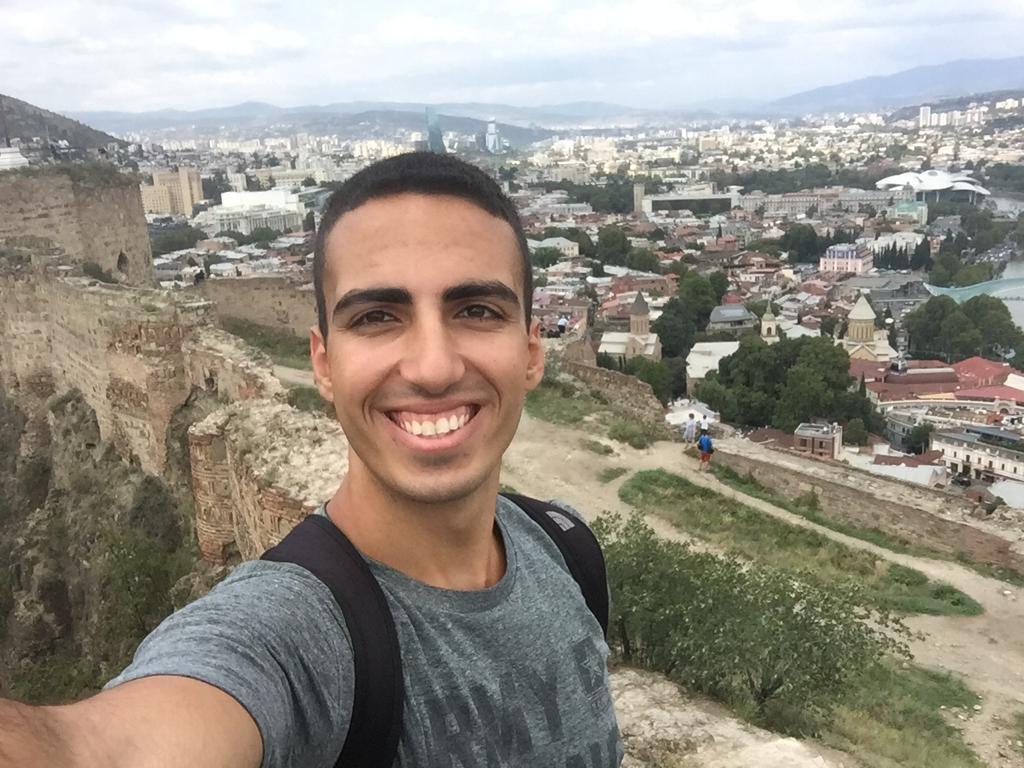
- Jan 29, 2020
- 15 min read
Winding through wooded mountains, the QL27C road out of Dalat is gorgeous, the mountain air crisp despite the clear skies. I spotted Jakob biking down the windy road ahead of me, nonchalant as ever, and continued towards the coast.
I had been assured by other travelers that gas stations were everywhere in Vietnam, so when my bike indicated I had less than half a tank left, good for roughly 60 kilometers, I didn't pay much notice and pushed on. Traffic and human settlement became thinner and thinner the further I got from Dalat until I reached the top of Khánh Lê Pass, also known as Omega Pass because of the many hairpin turns which look like an omega (Ω).
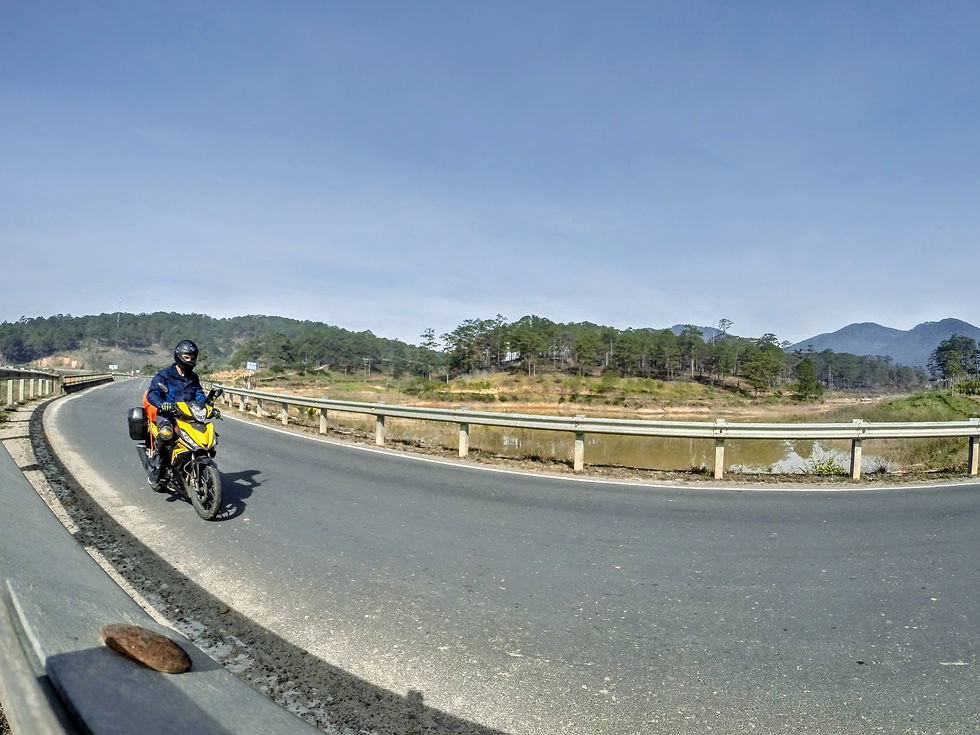
Down 1000 Meters in Neutral
The pass is considered one of the best streches of road in Vietnam, and I definitely understand why. Dropping over 1500 meters in elevation down a beautiful valley, the excellent road winds its way down to the coastal plain with waterfalls cascading mere feet from the pavement and turns that just get better and better.

I was unfortunately unable to enjoy the ride to the fullest, however, since my fuel was really low by this point. The holiday meant most gas stations being closed, so the final bar on the indicator was flashing before I even started descending, suggesting I had approximately 20 kilometers of fuel left, maybe 30 because of the drop in elevation. The nearest town was well beyond the pass, over 40 kilometers ahead, and there was no knowing how the holiday was affecting the gas stations there. I went into maximum fuel economy mode, pulling the clutch in at every opportunity, using gentle engine braking to control my speed in the turns, and resisting the temptation to stop and take photos at scenic spots for fear of wasting fuel. I think I probably used the throttle fewer than 10 times the whole way down, but my engine frustratingly kept stalling when I would pull the clutch in on the downhills. Finally, as my engine started running even rougher, I spotted a shack selling snacks by one of the turns. I pulled over and to my delight saw they had a sign advertising xăng (gas). Saved! The gas came in a water bottle and was almost twice as expensive as at a gas station, but I didn't care.
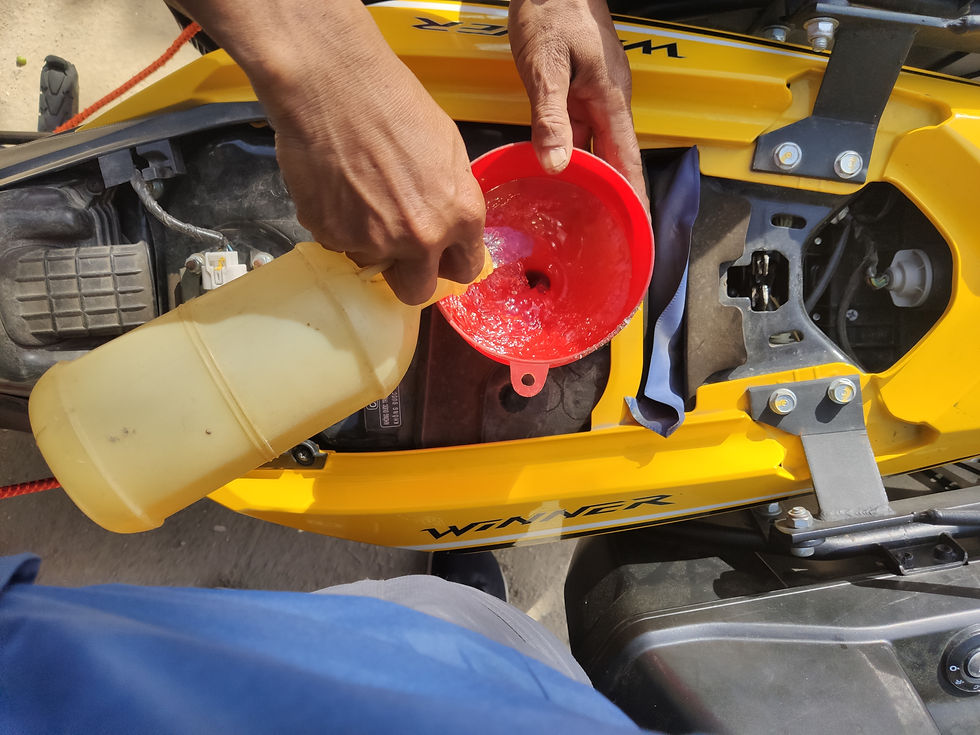
The Russian Riviera
Out of the mountains, the road was largely uninteresting until roughly 10 kilometers out of the city of Nha Trang, where it suddenly became arrow-straight, three lanes wide and full of buses. I had decided to visit Nha Trang because of the Tet celebrations, which I assumed would be more fun in a beach city than a mountain town, but I immediately started to question my decision. The only real cultural sight in the city is the complex of Hindu temples at Po Nagar, but pulling up by the entrance I could see masses of tourists on line to get in and crawling around the complex itself. No thanks.
I got some delicious iced sữa chua (lemon yogurt) and headed to my hostel, where I had lunch with a Dutchman named David who was working as an English teacher in Hanoi and a group of South Africans who were doing the same in Saigon. Vietnam and China are popular destinations for young Westerners who can live very comfortably teaching English due to the magical effects of purchasing power, and they all seemed to be traveling around since they, too, were off for the Lunar New Year.
Despite having plenty of history, Nha Trang is far from my kind of place, having evolved into an overgrown resort town over the last couple decades, including a massive theme park just offshore on the island of Vĩnh Nguyên.

The seaport and airport at nearby Cam Ranh Bay made the city an important supply point during the Vietnam War and were then used by the Russian military as late as 2003. Some may say the Russians never left the airbase, as it's now crawling with sun-deprived Slavs arriving by the plane load on chartered flights run by airlines you've never heard of from places you've likely never heard of, like the direct Nordwind flight from Nizhnevartovsk. The second-largest group is Koreans, who come to the beach side city in winter for some vitamin D. The end result of this is that English is the fourth-most common language spoken in Nha Trang and the fourth-most likely language to appear on a menu. Walk near the beach area and you'll see signs for tour providers, casinos, and restaurants in Russian and Korean (including the wonderfully-named "Katyusha Tour" below).

Trying to even out my tan at the beach with David (the elbow protectors had made some distinct tan lines on my arms) with 12,000 dong ($0.5) bottles of Saigon beer, two Russians showed up with a megaphone and a flag to get people to come to the Russian club later that night; we declined and returned to the hostel for happy hour.

Nha Trang being a famous party city, happy hour involves as much Saigon beer as you can drink in an hour, and a hostel employee named Max (who is fully Vietnamese but speaks with an Australian accent) was on hand with a card game to make sure we weren't wasting those 60 minutes. Many beers later, we had some Thai food and walked to the beach which was completely full of people gathered to watch the New Year's fireworks. The show lasted a good 20 minutes, after which chaos erupted as tens of thousands of people attempted to leave the beach promenade at once. Thankfully, we were walking distance from there and bypassed the crowds.


Airfield Drag Racing
New Year's Day had me riding out of Nha Trang on a terrible road to bypass the traffic on the coastal highway. I finally made it to the Phương Hồng Pass, which was great fun to ride but didn't have the incredible views of Omega Pass. Near the top of the pass, I passed some very barren hills, clearly affected by Agent Orange. It was a sad sight which was to repeat itself many times in the Central Highlands.
Back in the highlands after a day's break, the weather wasn't as cool as in Dalat and the landscape quite flat. I arrived in the town of M'Đrắk, where I explored an empty police garrison in which all the trash cans were shaped like penguins and a Buddhist pagoda full of holiday worshippers.
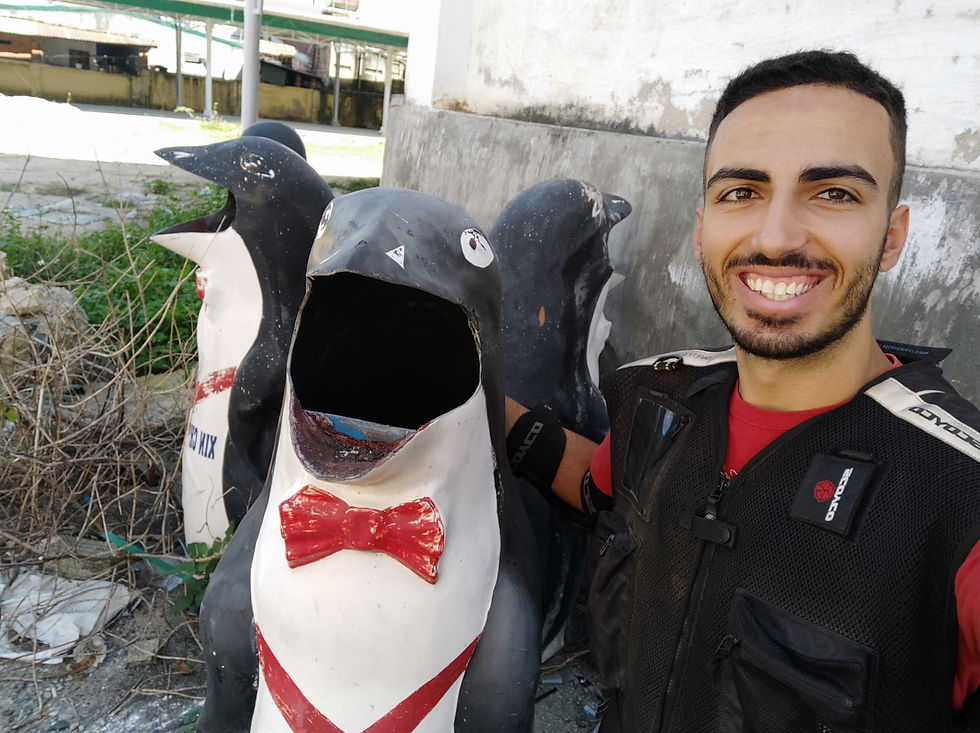
It being my first time inside a pagoda, the swastikas tattooed on the statues of Buddha initially made me take a very hard double take, until I realized they started the symbol first.

I rode into the hills near the town until the road suddenly became three lanes of smooth concrete in each direction, stretching straight as far as the eye could see. This was Khanh Duong, an American airfield built during the war, but I couldn't find much information about it online. Today, it was full of Vietnamese teenagers on scooters zooming up and down. I got some videos of myself riding and tested my bike to see how fast it could go (124 km/h with the needle at the red line in case you were wondering), catching a lot of wondering stares from everyone present.

My destination was Buôn Ma Thuột, a highlands town far enough off the beaten path to not have any hostels, so I booked myself a room in a small hotel called Ban Me, not to be confused with bánh mì, the popular Vietnamese baguette sandwiches. Like many places I had seen in Vietnam, motorcycles are parked indoors overnight; the feeling of riding on the marble floor straight into the lobby can only be described as bizzare.
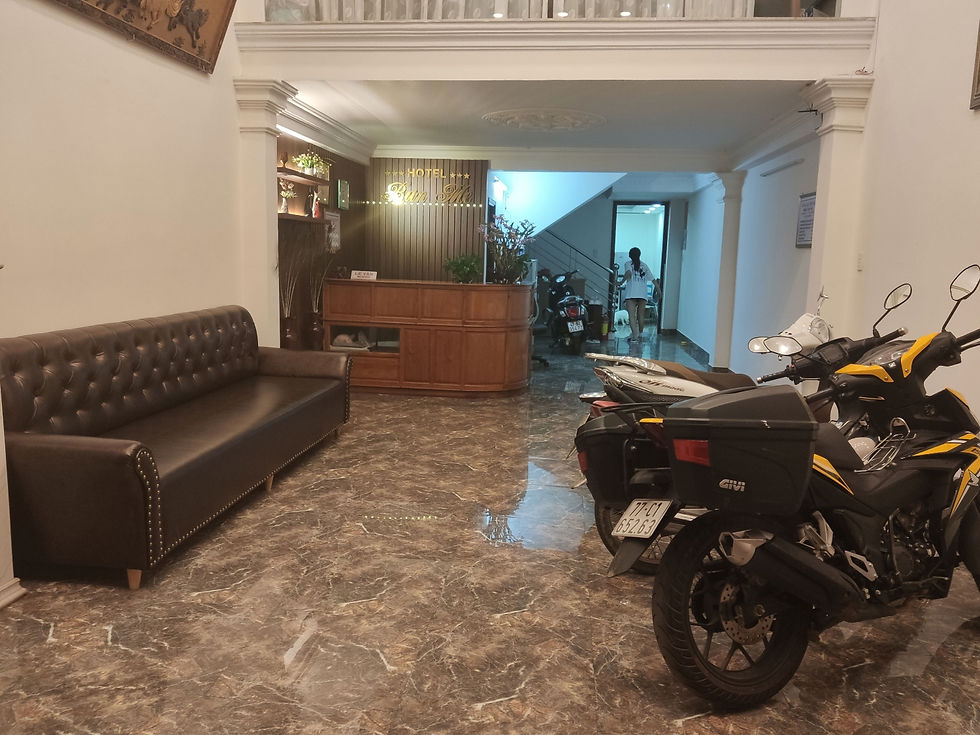
Buôn Ma Thuột is the epicenter of Vietnamese coffee country, and surprisingly chic coffee houses line the streets of the town center. The center is otherwise dominated by a huge victory monument commemorating the liberation of the town in March 1975, complete with very Communist-looking figures holding a flag and a concrete replica of a tank. Some locals were busy taking pictures and pulled me into their photos, amazed at how tall I was.
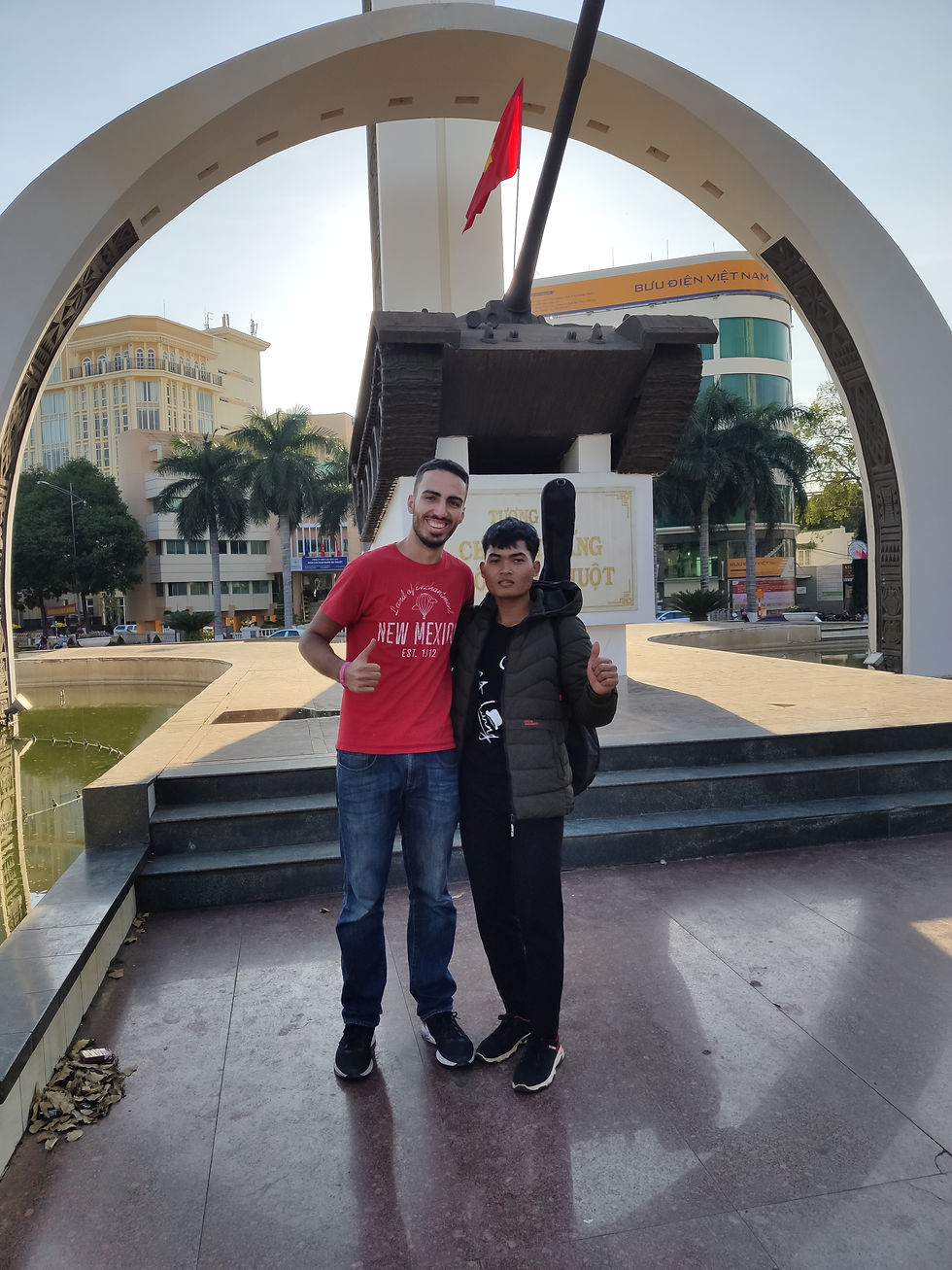
It still being the middle of Tet, the restaurants were all closed, but the cafés had apparently not received the memo, though unfortunately none of them serve any food. After lots of cruising around, I found an open roadside phở stand and called it an early night.
Flexible Speeding Tickets
I set off out of Buôn Ma Thuột on a brand-new road called the DT6, perfectly graded through reddish hills covered in coffee plantations. The road merged with another one and I spotted the letters DHCM on the distance markers, standing for Đường Hồ Chí Minh, or Ho Chi Minh Road. Not to be confused with the Ho Chi Minh Trail, the famous network of Viet Cong supply routes running north to south through the jungle (mainly in neighboring Laos and Cambodia), the DHCM is a highway running roughly along the same route to take pressure off the coastal highway. It would be my route of choice for many more miles on my way north.

About an hour down the road, I got pulled over by police officers in yellow uniforms highly reminiscent of the Red Army. The intercity speed limit in Vietnam is an abysmal 60 kilometers per hour, so it was only a matter of time before this was going to happen. Having received lots of tips from other riders, I decided to play dumb and speak broken English with a thick Israeli accent.
I was led into a small courtyard outside a convenience store, where another officer had set up camp with his laptop. I had been caught doing 70 a short distance up the road, according to a picture the officer received on Facebook Messenger from a colleague. After stalling and making him repeat every sentence multiple times, I learned the fine was to be 1 million dong ($43). "That's very much," I said in the worst Israeli accent I could manage. He opened a Word document. According to the table he showed me, the fine for a motorcycle 10-15 km/h over the speed limit was 600,000-1 million. "600,000," I said. "Ok."
The officer briefly disappeared as I pulled a 500,000 note out of my money belt and laid it on the table, placing more notes totalling another 100,000 next to it. He took the 500 and thanked me; the other 100 disappeared back into my pocket in the blink of an eye. Things got weird from here. He had returned with a bottle of cold water he had bought in the shop (presumably with his newfound wealth) and offered it to me. As I was putting my safety gear back on, he started making small talk, asking me where I was from, where I was going and trying to pronounce my name as it appeared on my driver's license. "Nice to meet you," he said, as if he hadn't just taken an official bribe from me, "drive slow". I shrugged. He shrugged. I rode off.
I did not drive slowly, however, and hardly an hour later I was pulled over again, this time for going 69, according to the laser-speedometer-camera contraption the policemen had. This time was much less cordial, the officer who could speak English best leading me to their truck where he filled out some form and asked me if I had 500,000 on me to pay. "Very much," I said, "I have maybe 2-300,000." Seemingly satisfied, he wrote down 300,000 dong ($13) on his form, asked me to sign it, and assured me the money would go in the bank, but I wasn't fooled. Fines that end up in the country's treasury tend to be non-negotiable.
Saved by a Rice Farmer
At this point, I did slow down and forced myself to ride at an excruciating 60-65 km/h. Until now, I had actually been riding closer to 80 most of the time, so I felt almost lucky to have been caught at relatively low speeds. The terrain, which had been very flat until now, gradually became more rolling until some mountains became visible in the distance. Despite the reduction in speed, I made it to Pleiku, which was to be my next destination, around 12:30. I really wanted to continue onwards to Kon Tum, the next city only an hour further north, to get a rest day the next day, but my guesthouse booking was non-refundable so I showed up hoping they would agree to cancel it.
Luck was finally on my side. The guesthouse was deserted and there was no answer on the two phone numbers I had. The neighboring house was hosting a large family Tet meal, and roughly a dozen kids came out to have a look at the strange man in the suit of armor and practice their extremely basic English on me. After twenty minutes with no sign of life from my would-be hosts, I decided to leave, figuring that if booking.com demanded I pay for the cancelled booking I could tell them nobody was home.
Off the highway between Pleiku and Kon Tum is Biển Hồ, a volcanic lake that was supposed to be beautiful. I made the detour, rode across a very rickety bridge, and found myself on a concrete path circling the lake through thick forest. Frustratingly, when constructing the path nobody bothered to get rid of the trees, so it was more of a forest slalom path which took my attention away from the scenery.
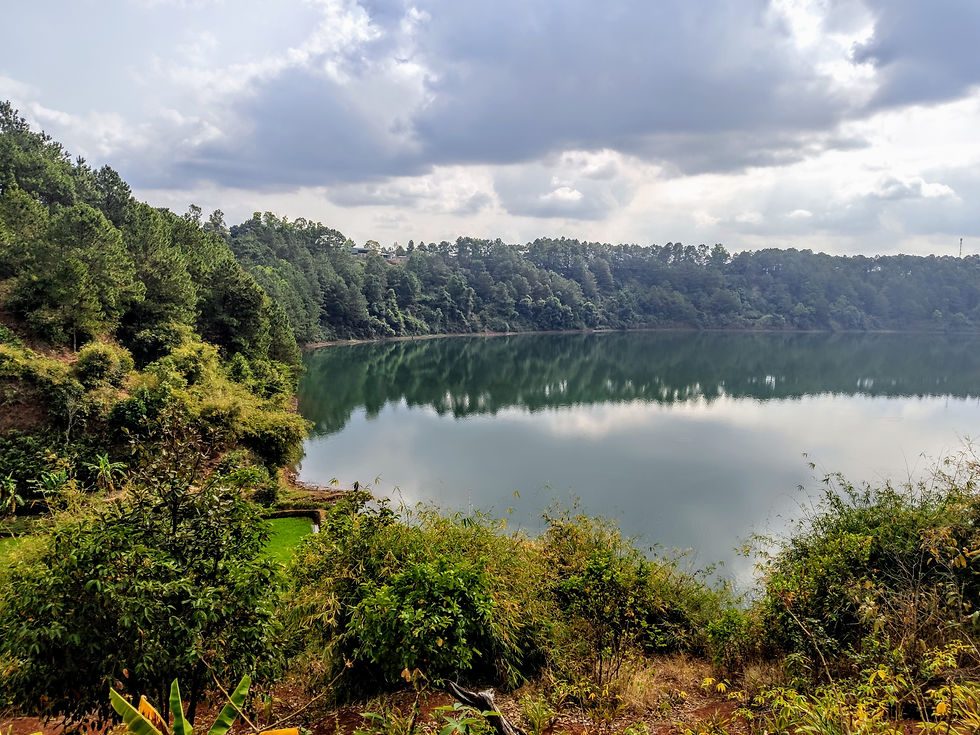

The path came to an end in a small clearing, with a dirt path continuing onwards. Buoyed by my sense of discovery, I kept riding on the path that rapidly got narrower and steeper, leaving me with no other option to continue but ahead, in hope of finding a spot wide enough to turn around.
The path became so steep that I couldn't properly brake - I was afraid the front brake would make me flip over and the back brake rapidly locked my wheel and caused me to slide. I inched my way down until eventually drifting my rear wheel, causing my engine to stall and me to lose balance, falling onto my side.
I pushed the bike off me and finally found a flattish spot which seemed big enough to turn around. Pushing and pulling the 130 kilograms of bike and luggage through the soft ground and cursing myself for being so stupid, I managed to get it to point back uphill, but only just. I knew I had one shot to make it back up the hill, and if I stalled I wouldn't be able to restart on the slope. Focusing all my attention on the clutch and gas, I made it up approximately half the slope before it proved too much for the poor 150 cc engine and the road tires and I stalled out, nearly falling over in the process.

I was now in a major predicament. The only thing holding the bike still on the slope was the gearbox and the second I would pull in the clutch to try and start the engine I would rapidly start rolling downhill. Braking was no use; the bike simply became a ballistic object and would terrifyingly skid backwards towards a high drop, making gaining traction all but impossible. To say I was frustrated would be a massive understatement; I was literally screaming at my own stupidity as I removed layers of clothing to try and cool down.
It was in this rather unfortunate situation that help materialized in a surprising form. At the bottom of the slope were some terraces used to grow rice; a local farmer who had seen me struggling was now bounding up the hill to help me. He held the back of my bike to allow me to start the engine, but I stalled out again after a few feet. This repeated itself a few times until I realized I was shaking so hard I would never be able to make it up on my own, so I indicated to him that we should switch positions. He gave it a few tries and finally got the bike in gear; we were both running like madmen up the hill to push the bike before it stalled again. We made it to the top and I practically collapsed into the ground, shouting with glee; some local teenagers who were there with their bikes (and wise enough not to continue) almost died laughing at me. The rice farmer introduced himself as Muon and refused to accept any money I offered him as thanks; I was amazed at his kindness and incredibly grateful.

Defeated on Charlie Hill
After catching my breath and dusting myself off, I rode to Kon Tum, where I managed to get the last bed at a popular homestay. After being served dinner, I understood why it was so popular: the family had prepared a full Tet feast for us, with traditional holiday foods such as bánh tét (rice and mung bean rolls similar to sushi), giò lụa (sausage), and hành muối (pickled spring onion).
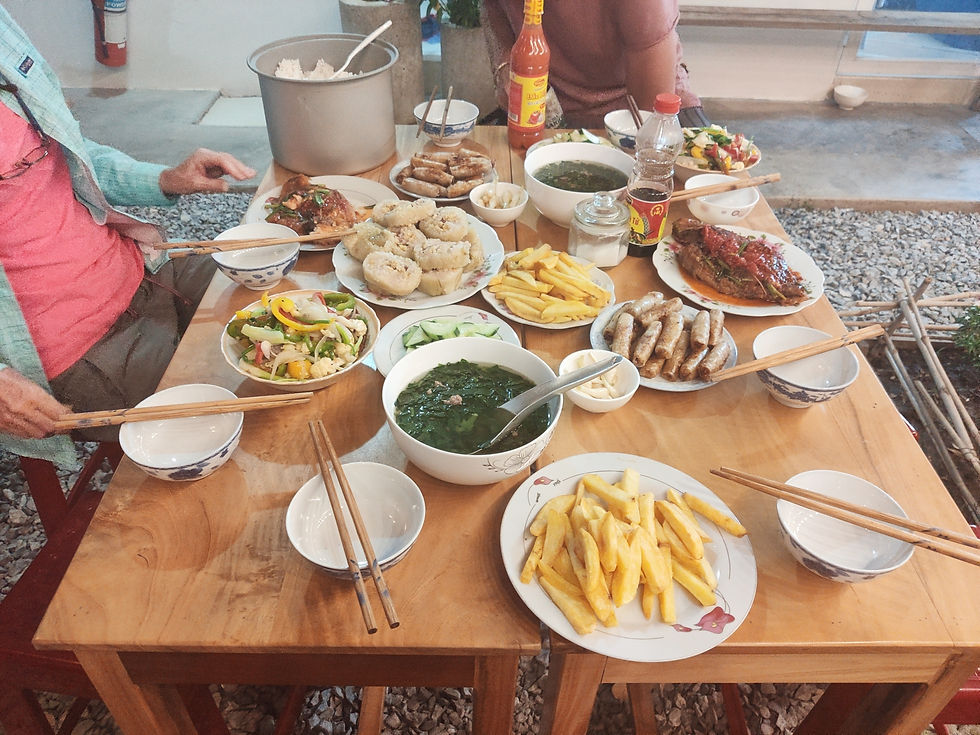
Literally every guest at the homestay but one was riding, and they recommended I ride a loop of the surrounding area the next day. A bit of research showed the loop could also easily include some important war sites, so I was sold.
I set off the next morning and headed west, towards the Cambodian border. I turned north to follow a road called the DT675, which led me way off the beaten track. I rode through little impoverished villages on a road that seemingly had more potholes than pavement, winding its way through dusty hills and plantations that had curious "scarves" wrapped around each tree.

This area was inhabited by the H'mong minority, a dark and weathered people clearly unaccustomed to foreign visitors, judging by the way the kids crowded around me when I stopped in one of the villages. The lack of development showed clearly; I saw plenty of kids seemingly aged 9-10 on motorbikes.
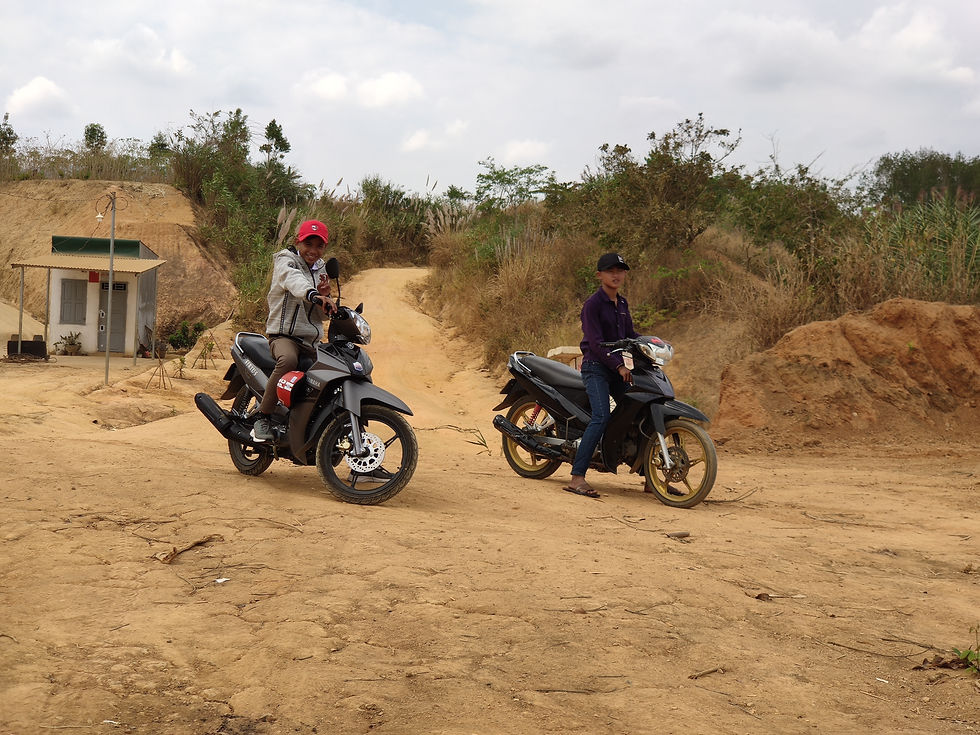
This was prime Vietnam War territory, the site of the battles for Dak To and Kon Tum. To my left was a mountain chain that had once hosted a string of US and South Vietnamese fire support bases (FSBs) commanding the entire region; North Vietnamese attacks on the bases had earned it the nickname Rocket Ridge. Two of these former bases seemed to be within reach of the road I was on. I passed the road to the first, FSB Delta, but it seemed too rough so I decided to give it a pass.

A few kilometers further down the road, I reached the path leading to FSB Charlie. The path was unpaved but looked quite good on Google Maps so I decided to give it a shot. I rode on a multicolored sand track, rising high above the valley floor.
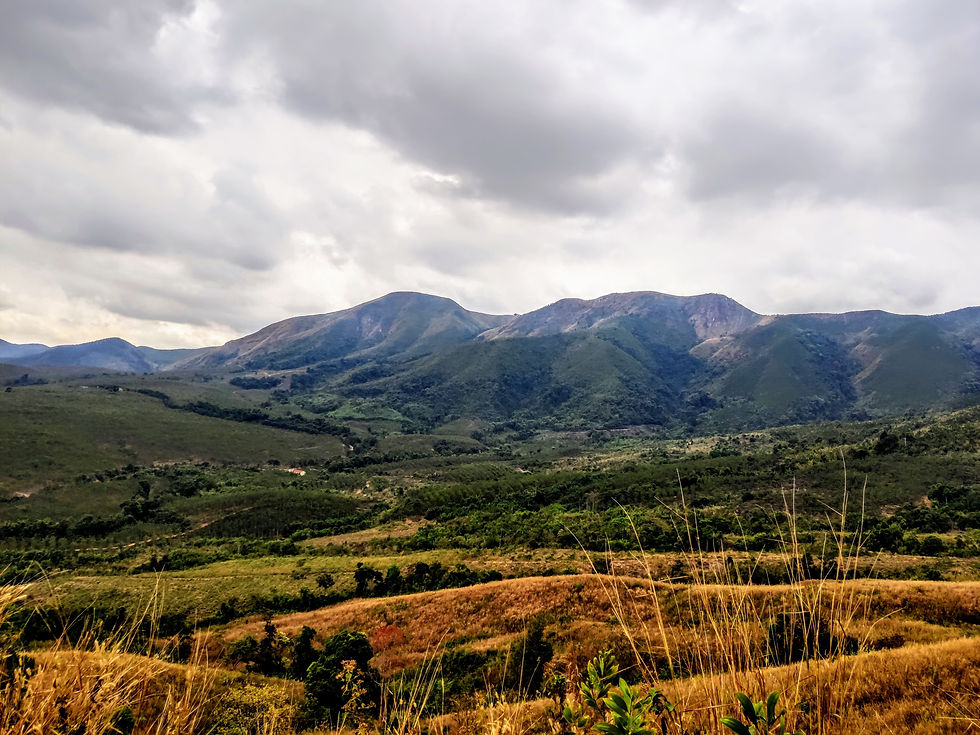
It was very technical riding, following a narrow path on slippery terrain, and it got the best of me about halfway up. I slid on the loose sand, rapidly tumbling to a stop with the bike on top of me. I was totally fine (and had gotten the fall on film!) if rather dusty; the only casualty was my phone holder which had cleanly snapped in two.

I dusted myself off and decided to push on more cautiously. I reached a small river crossing and forded without incident, the path taking me between lovely plantations of plants I couldn't identify. The track suddenly became much steeper and the soil looser, my bike struggling to gain traction and progress slowed to inches at a time. My engine running hot and my frustration running high, I decided to cut my losses and return downhill. Like the South Vietnamese army in April 1972, I had been defeated on Charlie Hill.

Battle Scars
The way down passed without incident and I eventually made it out of H'mong country and onto the main road. I rode further north through the town of Đắk Tô, which had once hosted a massive US Army and Special Forces presence. Right off the highway was the former site of Tân Cảnh Base Camp, established in 1962 to monitor Viet Cong activity in the surrounding jungle and overrun by the North Vietnamese Army in the Easter Offensive of April 1972. Today, the former airstrip is used to dry soil and the eastern part of the base has, somewhat fittingly, become a cemetery. There's no sign of any buildings, but there are very few tall trees around, a clear sign of the massive artillery bombardment the base sustained.


The next stop was Đắk Tô Base Camp or Phoenix Airfield, built in 1967 to host the growing numbers of US military personnel in the area. There the presence of a base was more obvious, the aprons and runway still clearly visible despite the encroaching brush. Letting my mind wander, I could picture the apron full of transport aircraft, two of which were hit by mortar fire in November 1967 during the Battle of Dak To, setting the base ablaze.

The base had a clear view of the mountains to the west, where US forces had once been sent on deadly missions to search for Northern forces, who had secretly built up well-defended positions on nearly every hill and set successful ambushes time and again.
The landscape still showed some clear signs of the fighting, if you knew what to look for. Any description of the fighting near Dak To will mention the thick jungle, but you'll be hard-pressed to find it today. Desperate to flush the enemy out, the US dropped huge amounts of Agent Orange on the entire area, and the barren brown hills stick out very obviously.

Over 150 thousand artillery rounds were fired into these hills and thousands more bombs dropped during the heavy fighting in the end of 1967 which had claimed over 2000 casualties, leaving a scarred landscape which even over 40 years later bears the marks of the fighting. Contaminated soil doesn't support crop growth, so this useless, unsafe land remains cratered and full of unnatural terrain formations. In that sense, Dak To is like other sites of tragedy I've visited that have since been returned to nature, like Treblinka or the Valley of Tears in the Golan Heights. Everything seems so normal, yet it's a depressing place once you start making the connections between the landscape and its troubled history.
Riding back towards Kon Tum, I stopped at a several memorials for the victims of the fighting in the area. One of the memorials is constructed on "Hill 601", where Southern jets dropped bombs on the battlefield below, killing at least 130 of their own and many hundreds of the enemy. After the war, the remains of hundreds of bodies were found on the hill, prompting the construction of the memorial and earning the place the name "Skull Hill".
There is a small altar at the foot of the hill with the Vietnamese inscription "Đồng Sanh Lạc Quốc", literally "we were born in the same country". Vietnamese words have multiple meanings, however, so according to some online sources it can also be interpreted as "co-born and country lost", a uniquely provocative statement in a country run by an authoritarian regime with a very clear narrative of the events of the 1950s-70s.
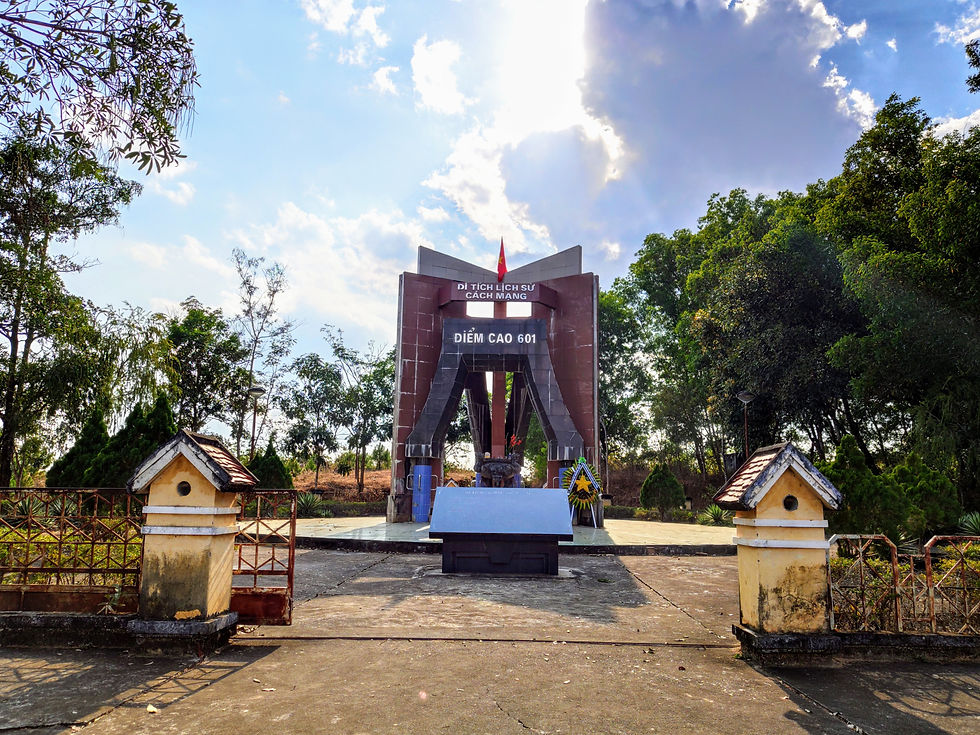

As the sun got low in the sky, I rounded out my loop of the area with a visit to a pagoda and the cathedral of Kon Tum. It had been a hell of a day.






Comments